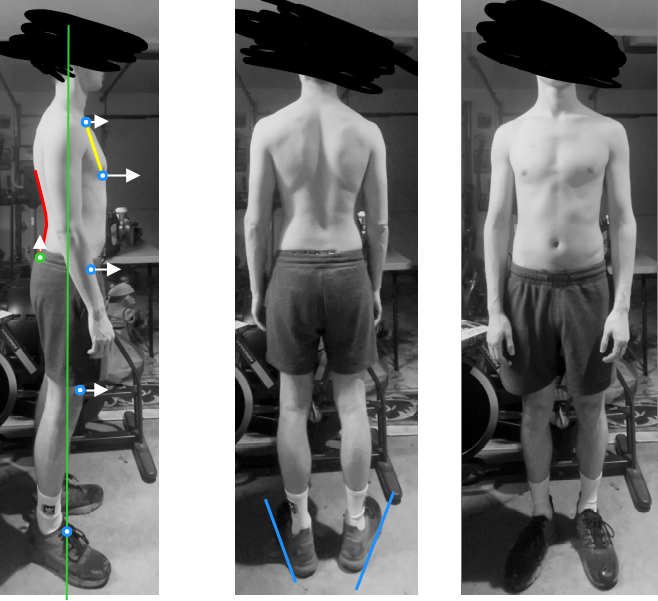Assessment context and image originals from this thread: https://www.reddit.com/r/PostureAssesments/comments/15kqffg/chronic_neck_and_upper_back_tightness_and/

Before I go through the drawing, let me set a bit of context and define terms.
One way to look at yourself is as if it would be machine. You have bones (levers), muscles (actuators moving the levers) and fascia (which is an elastic spring designed to transfer load / force). This entire mechanism operates in the field of gravity, which means that equilibrium must be maintained in order for the structure to keep upright.
Based on the anatomical design of our bones and fascia, there exists one particular "shape" (position of mechanical advantage) where all the mentioned systems work together in order to obtain the goal of standing upright. There is also whole lot of "shapes" that are not in their optimal coordinations. Yours is one of them.
Because bones don't change shape (as muscles do), we use the bones as landmarks to be able to measure and reference position of each part of the mechanism.
What you currently see is a still image (a snapshot of a movement of parts of your mechanism in time). We could say that at the time of the camera shutter, you have been moving your bones in the following positions:
- Feet not placed correctly (toes wide apart, heels together). The blue lines (outsteps) should be parallel, not converging at the back. You are also consistently placing right foot in front of the left one. Remember that for later.
- Ankles and knees are released (not in full extension).
- iliacs (anterior superior iliac spine) are too far forward and sacrum is lifted up. That rotates your pelvis forward and down at the front.
- Your ribcage is rotating in exactly the opposite direction. That is top of ribcage goes back and bottom rib goes forward.
- These two rotations of lower and upper torso respectively act on the spine (red curve) arching it as seen. This is what we call shortening and narrowing of your torso, as that's what's happening.
- The yellow line is your sternum (front of ribcage) and shows the current slant back at the top / forward at the bottom.
- All these blue markers should ideally be on the green line.
- You can also see your arms being heavily retracted back which brings your shoulders together (narrowing of back). The crests of your scapulas are clearly protruding at the back. If your back is widened, you wouldn't see any creases there.
- Head is also retracted too far back.
- Remember the right foot placed forward to the left? So is your right knee and right iliac (hip). To compensate for this R/L imbalance, your left arm is pulled further backwards then your right. That of course also lifts the entire left arm higher up.
Now all these movements you have done prior to the shutter going off, have been done habitually. You didn't really asked for it, it just happened. Unconsciously.
The problem is, that such mal-coordination is not good for you. Your breathing, circulation, digestion are all compromised. Not speaking about the associated pain / discomfort you are experiencing.
To get out of this pickle, you can learn the Initial Alexander Technique or what we call "conscious guidance and control". Basically, you learn how the mechanism operates with the help of basic physics, mechanics and anatomy and design a whole new set of movements. These new movements, if executed, would adjust the mechanism into better working position (mechanical advantage) and therefore would change your posture (and most likely fix your issues as a byproduct of the process).